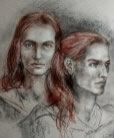d. Dwarves
– a stocky, hardy, secretive and craft-loving people created by Aulë; given life by Eru Ilúvatar; the first dwarves (Seven Fathers of Dwarves, of whom the only known one is Durin the Deathless) awakened in several mountain ranges in Middle-earth after the awakening of the Elves; they scarcely befriended other peoples; they held mutual grudges against most Elves, Ents, and Orcs; like with Elves, there are several kindreds of Dwarves and they have few children.
Also called: Naugrim [now-grim] (in Elvish), Khazâd (in Dwarvish)
Skills: Dwarves in The Silmarillion are renowned as smiths, wrights and jewel-wrights, stonemasons and architects, traders, and warriors whose armour can withstand dragon fire. Unmatched in making of chain-mail and forging steel.
Major works: Dwarves assisted with the making of the Elven cities of Menegroth (capital of Doriath) and Nargothrond which were delved in stone; their other famous works are the realm of Moria and its gates, the necklace Nauglamír, the Dragon-helm of Dor-Lómin, and the sword Narsil.
Chief dwellings: Blue Mountains- the cities of Belegost and Nogrod (both possibly destroyed during the re-shaping of Middle-earth after Morgoth’s downfall); Misty Mountains- the realm of Moria.
Major friendships and leagues:
– friendships: with Eöl the Dark Elf, with the Elven smiths of Eregion (Hollin)
– bussiness leagues: the Elves of Doriath, Nargothrond and Thargelion.
Major conflicts and wars (chronologically):
– BATTLE OF UNNUMBERED TEARS (NIRNAETH ARNOEDIAD) – as allies of the Elves and faithful Men against Morgoth; remembered for their bravery in fighting dragons, and wounding Glaurung the main dragon.
– FALL OF DORIATH – a frequently remembered conflict between Dwarves and Elves; started by the Dwarves coveting King Thingol’s Silmaril and Thingol insulting them and refusing to pay them for their work, upon which the Dwarves killed the King and fled from the realm of Doriath; most of them were slain in revenge by the Elves of Doriath as they fled; a Dwarf army retaliated afterwards, causing the first fall of Doriath. (Doriath was later laid in utter ruin during the attack of the Sons of Fëanor).
Half-truths reported to, and spread by, both sides seem to play a key role in this conflict which in the later ages influenced the relationships between Elves and Dwarves.
You know it from: It is discussed (without concrete names) in The Hobbit (King Thranduil’s grudge against Dwarves), and hinted at in LotR (the debate of Legolas, Gimli and Gandalf before the Gate of Moria; Lothlórien).
– WAR OF SAURON ON EREGION (HOLLIN) – as allies of Elves against Sauron in the Second Age; attacked Sauron’s forces from the safety of Moria.*
Famous Silmarillion dwarves (all lived during the First Age):
Durin the Deathless [‘doo-rin] – the most famous of the Seven Fathers of Dwarves; lived in Moria; his kindred was generally friendly with Elves; he had six namesakes in the later ages who were believed to be his reincarnates.
You know him from: he’s mentioned several times in both The Hobbit and LotR (‘Durin’s Day’ etc.)
Azaghâl [ah-zahg-‘khaal] – the lord of the Dwarves of Belegost in Blue Mountains; famous for wounding Glaurung the dragon in the Battle of Unnumbered Tears where he died.

Telchar [‘tehl-khahr] – a famous craftsman; made Narsil (cf. Aragorn’s presentation of his sword in Edoras in TTT), and Angrist, the blade that cut the Silmaril from Morgoth’s crown.









